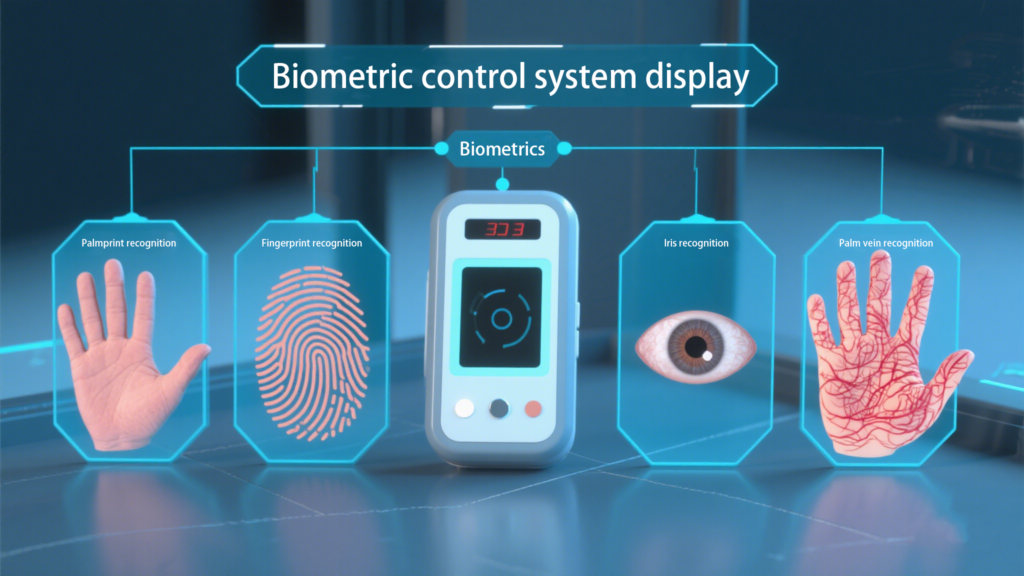What Is Iris Recognition Technology
Because each iris is completely unique (even between identical twins), iris scanning technology provides an extremely reliable way to authenticate individuals in high-security environments. This article explores how iris recognition works, its key benefits, and where it’s being used today.
How Does Iris Recognition Work?
The process involves several key steps:
1.Image Capture
A high-resolution camera captures a detailed image of the eye, often enhanced by infrared light. This allows for clear iris imaging even if the user is wearing glasses or in varying lighting conditions, ensuring accurate data collection without requiring close contact with the user.
2. Iris Localization
Advanced image processing algorithms identify the exact location of the iris within the captured image. The system effectively excludes eyelids, eyelashes, and reflections, isolating the iris region to ensure the biometric data extracted is precise and suitable for reliable recognition.
3. Feature Extraction
Unique iris features—such as radial patterns, furrows, rings, and freckles—are analyzed and converted into a digital code. This biometric template is highly distinctive and remains unchanged over time, making it ideal for secure identification in both standalone and integrated systems.


Key Features of Iris Recognition Technology
1.High Accuracy
Iris recognition delivers exceptional precision, with extremely low false acceptance rates (FAR) and false rejection rates (FRR). Thanks to the unique and stable nature of the iris pattern, it can differentiate between millions of individuals with unmatched reliability—even among identical twins.
2.Contactless Verification
The entire process is non-intrusive and hygienic, requiring no physical contact with any device. Users simply glance at a camera, making it ideal for high-traffic areas, healthcare settings, and during disease-prevention protocols where minimizing touch is essential.
3.Speed
Advanced iris recognition systems can complete the matching process in under a second, even when scanning against large databases. This makes it suitable for real-time identity verification in airports, border control, and enterprise environments requiring quick and secure access.
4.Scalability
Iris recognition solutions are highly scalable. They can be deployed in small offices for staff access control or scaled up to manage millions of identities in national ID programs, voter registration, or border management systems with equal efficiency.
5.Resistance to Forgery
Because the iris lies behind the transparent cornea, it is protected from external wear and tampering. Its complexity and inaccessibility make it nearly impossible to replicate using photos, masks, or fake biometrics, offering a high level of security.
Compared to other biometric technologies, iris recognition is often chosen for high-security applications that demand both precision and durability.
Applications of Iris Recognition
1.Government and Border Control
Iris recognition is widely used for passport verification, immigration processing, and national ID programs. It enables fast and accurate identity confirmation, effectively preventing identity fraud and unauthorized entry, thereby enhancing national security and border management efficiency.
2.Healthcare
In healthcare, iris recognition provides rapid and reliable patient identification, reducing medical errors and ensuring secure access to sensitive medical records. This technology improves hospital workflow and enhances patient safety and privacy protection.
3.Education
Iris recognition in educational institutions ensures that only authorized students and staff gain access to classrooms, laboratories, and campus facilities. It enhances campus security, facilitates accurate attendance tracking, and streamlines student identity management.
4.Corporate Offices
Corporate offices use iris recognition systems to implement high-security access control, preventing unauthorized personnel from entering sensitive areas. This protects company assets and confidential information while enabling seamless, contactless entry for employees.
5.Banking & Finance
In banking and finance, iris recognition offers secure and convenient authentication for mobile banking apps, ATM access, and branch entry. Its high accuracy and resistance to fraud safeguard financial transactions and customer accounts against unauthorized access.
These use cases reflect the growing global adoption of iris biometric verification in everyday life.
Other Biometric Authentication Methods
While iris recognition is among the most secure, there are other biometric verification methods used depending on the application:
Fingerprint Recognition: Common in smartphones and attendance systems.
Facial Recognition: Ideal for quick, contactless authentication.
Palm Vein Recognition: High-security access in banking and healthcare.
Voice Recognition: Used in telebanking and call centers.
Behavioral Biometrics: Authentication based on typing or movement patterns.
Each method has its own strengths and weaknesses. Selecting the right one depends on your security needs, user environment, and operational goals.
Is Iris Recognition Right for You?
If you’re looking for a biometric solution that offers unmatched accuracy, durability, and security, iris recognition technology is a leading contender. Whether you’re managing national ID systems, controlling access to sensitive data, or simply improving user verification, this method provides a secure and future-proof option.
Iris recognition technology application video
HFSecurity Iris Recognition Technology Advantages
HFSecurity leverages cutting-edge iris recognition technology that delivers exceptional accuracy and fast verification speeds. Our systems use advanced algorithms to capture high-resolution iris images, ensuring reliable identification even in challenging lighting conditions. Moreover, HFSecurity’s iris scanners feature robust anti-spoofing measures to prevent fraudulent access. Designed for seamless integration, our technology supports diverse applications from secure access control to government ID verification, reflecting our commitment to security and innovation.
FAQ
Yes, in terms of accuracy and hygiene, iris recognition is generally more reliable, especially in high-security environments.
Yes, it uses infrared light which is safe and non-invasive, posing no harm to the eyes.
Yes, modern systems can accurately recognize irises even through most glasses and lenses.
Extremely secure — iris data is encrypted and stored securely, and is very difficult to replicate.
Government, healthcare, finance, and corporate sectors are the main industries utilizing iris biometrics.


